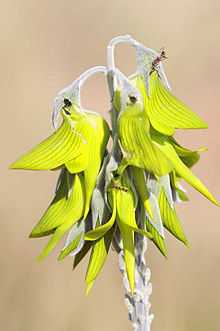Crotalaria cunninghamii
| Green Birdflower | |
|---|---|
 | |
| Scientific classification | |
| Kingdom: | Plantae |
| (unranked): | Angiosperms |
| (unranked): | Eudicots |
| (unranked): | Rosids |
| Order: | Fabales |
| Family: | Fabaceae |
| Genus: | Crotalaria |
| Species: | C. cunninghamii |
| Binomial name | |
| Crotalaria cunninghamii Robert Brown | |


Crotalaria cunninghamii, also known as Green Birdflower or Regal Birdflower, is a plant of the legume family Fabaceae. It is native to, and widespread in, inland northern Australia. It is named after early 19th century botanist Allan Cunningham. It is a coloniser of unstable sand dunes, along beaches and in Mulga communities. It is pollinated by large bees and by honeyeaters.
Description
Green Birdflower is a perennial shrub that grows to about 1-3 m in height. It has hairy or woolly branches and dull green foliage. The oval leaves are about 30 mm long, the large and greenish pea flowers are streaked with fine black lines, and the club-shaped seed pods are up to 50 mm long. The plant’s flowers grow on long spikes at the ends of its branches.[1] The flower resembles a bird attached by its beak to the central stalk of the flowerhead. [2]
Uses and cultivation
The sap from the leaves was used by Aboriginal people to treat eye infections.[1] [2]
Green Birdflower can be grown in warm areas. It needs well-drained soils and a position in full sun. It is not suited to cold climates or where there are frosts. Propagation is from seed, which readily germinates after boiling water treatment, or from cuttings.[1]
References
- "Crotalaria cunninghamii". Australian Native Plants Society. Updated November 2007. Retrieved 19 April 2010.
- "Plants at the AALBG: Regal birdflower (Crotalaria cunninghamii)". Australian Arid Lands Botanic Garden. 2010. Retrieved 19 April 2010.